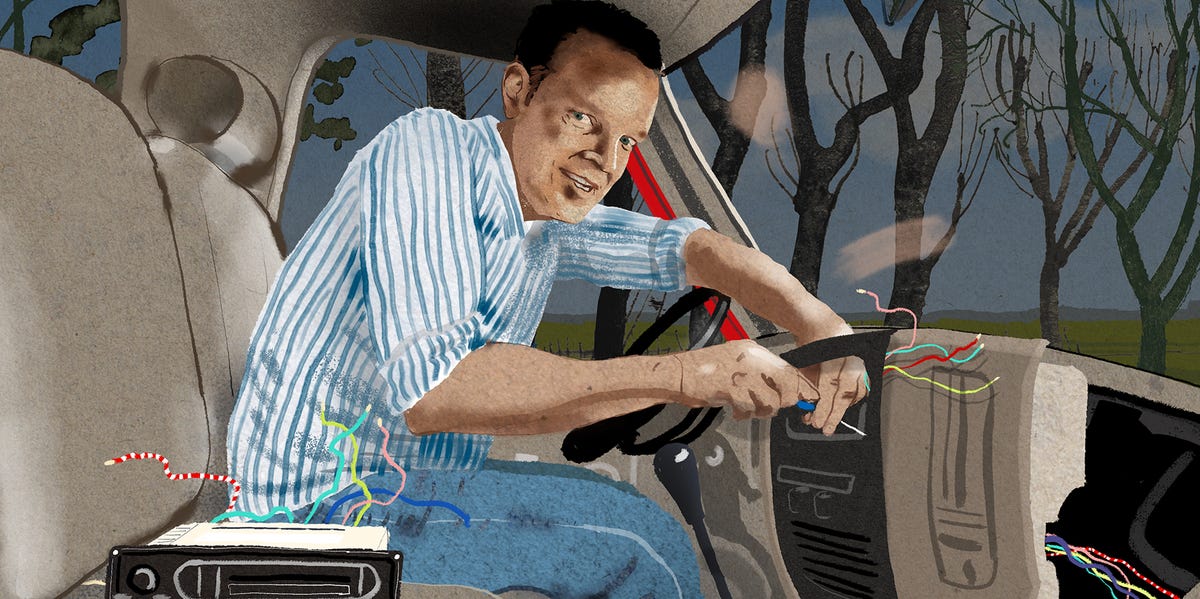Ezra Dyer: Sound Opinions

Illustration by Derek BaconCar and Driver
From the May 2022 issue of Car and Driver.
The McIntosh MX950 sound system in the new Jeep Grand Cherokee will split your head open. It’s got a 17-channel amp, 19 speakers, and, as the name implies, 950 watts. The bass will rattle loose change out of your pockets. A punchy snare can make your socks fall down. If you told me you want to feel like you’re in the recording studio with Steely Dan, I’d say be careful what you wish for, but the McIntosh will take you there. You really wouldn’t want to change anything about it. Which is fortunate, because you can’t.
Car stereos from my formative years—the 1980s and ’90s—were mostly standardized, with a DIN-size head unit directly powering whatever flimsy speakers the manufacturer deigned to provide. But both head unit and speakers were easy to replace, and once you had the interior torn apart anyway, you might as well add an amp and a subwoofer. By high school, I was well versed in impedances and crossover slopes and fuse blocks, and I could install my own stuff semi-competently, as could my friends. This free labor allowed us to plow more of our summer-job earnings into increasingly ridiculous sound systems, until I came to believe that having two 12-inch subwoofers (as I did in the IROC) was the bare minimum to do justice to “Whoomp! (There It Is).” My friend Adam had a dual 15-inch speaker box that he once pulled out of his Subaru and used to DJ a high-school dance. That’s where we set our standards: If your car stereo sounds loud in a gym, it’s probably almost loud enough for your car.
I first foresaw the end of zany DIY car stereos in the early 2000s, when my buddy Dave tried to put a relatively restrained system (only one amp and 10-inch sub) in his Saab 9-3. Even with a professional installation, the aftermarket head unit disabled the Saab’s security system, which was somehow networked into the factory stereo. Dave could crank Elton John’s “Tiny Dancer” or have a functioning keyless entry system, but apparently not both. The 9-3 presaged the imminent demise of sound systems that could be hot-rodded by high-school kids.
But you know what doesn’t have an infotainment system? The regular-cab 2003 Ram that I bought last year. Among its minor foibles was a dead stereo, so I decided to resurrect my old skills and revive it with a semi-boomin’ system. Since aftermarket head units typically evince the cool aesthetic restraint of a Japanese pachinko parlor, I bought a Chrysler OEM replacement (from the creatively named 1 Factory Radio company) discreetly hacked with an auxiliary jack so you can plug in a phone. Then I ordered a slim eight-inch powered subwoofer to hide under the seat and embarked on a fun and rewarding project. Ah, that old familiar feeling of wishing you paid someone else to do this! I remember it well. Speaking of which, did you know you have to remove the Ram’s upper seatbelt anchors to get at the rear speakers? Running the power cable to the battery required breaching some kind of firewall grommet with a coat hanger. In the process, I lacerated my hand on various unseen razor-sharp pieces of metal that Dodge included just to frustrate this process and get you to trade your dumb truck for one with the Infinity sound system.
After going full MacGruber and tapping into a switched hot wire to get the amp to wake up, I had a system that looked stock but thumped hard. Which is great, except now I’m thinking of all the other stupid things I could do—kick-panel components, multiple amps, behind-the-seat sub boxes. Maybe I don’t know how to build a car stereo that sounds as good as a McIntosh MX950. But I bet I still know how to make one that’s louder.
This content is created and maintained by a third party, and imported onto this page to help users provide their email addresses. You may be able to find more information about this and similar content at piano.io



